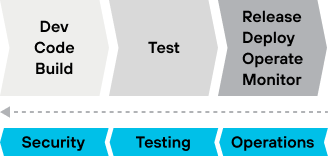Meet Acme Financial–Our Totally
Fictional Company
Let’s look at how one organization solved its pipeline security challenges by using Prisma® Cloud
to extend
visibility and control across the full app lifecycle, adopting a true shift-left security model.
Acme Financial is a financial services company that we created just for the purposes of this story. As we’ll
see, Acme had more than a few speed bumps on its journey to becoming a truly innovative cloud-centric
organization, but adopting Prisma Cloud allowed the company to truly commit to a shift-left cloud security
model.
We didn’t just make Acme up, though—it’s based on the hypothetical composite organization featured in
Forrester’s The
Total ImpactTM Of Palo Alto Networks Prisma Cloud. In the report, Forrester analyzed the
major
organizational and role-based impacts that adopting Prisma Cloud would offer a company like Acme Corp.
Acme Dev Team: A Lot on Their Plate
The Acme Financial development team was responsible for crafting code for business-critical apps, plus every
step of the development process, from coding to compilation to testing and patching. That’s a lot of
responsibility and influence for a single department.
Like many organizations, Acme’s pace of development has accelerated—the CI/CD pipeline runs faster than ever
and faces lots of top-down business pressure to deliver faster. Like similar organizations, new code
deployment frequency increased 68% in 2023.1
Acme Security: Always on the Back Foot
Acme security teams struggled to keep up with the pace and agility of these new development cycles without
throttling production and innovation. Outnumbered 20:1 by Acme devs, SecOps was in firefighting mode, reacting
to runtime risks rather than proactively managing vulnerabilities throughout the entire CI/CD pipeline. Not
catching vulnerabilities and misconfigurations also created a lot more work for SecOps in production. One
mistake early on could become hundreds of alerts later.
Acme’s time-crunched developers would do a merge and realize they’d deployed packages with vulnerabilities
into the runtime environment.
Acme’s New App: Anvil
Acme Financial’s development and security paradigm worked well enough—until it didn’t.
The senior leadership team wanted a sophisticated portfolio application for Acme’s business customers.
Code-named “Anvil,” the ambitious new app would include advanced features supported by extensive APIs to
connect it to other Acme systems and ultimately, to the public internet.
Not incidentally, this app would serve as a flagship digital initiative for Acme’s investors, so it had to
launch by Q4 in time for the big annual earnings call. The dev team had just 6 months to get a working version
of the business investment portfolio app into the market.
Both DevOps and security architects pointed out the risks in rushing an innovative new app to market without
ensuring comprehensive security measures. To save time, the team leveraged some code from a similar
consumer-level app that Acme had developed previously, despite the CISO’s reservations about potential
vulnerabilities within the code.
Disconnected Tools = Lack of Visibility
The dev team crunched for months, working heroically to get Anvil into production despite constant pivots and
new features being added.
All the while, the security team was flagging their lack of visibility into production code and the risk of
exposing vulnerable code and secrets to public view.
Like many companies, Acme relied on about a dozen disconnected traditional security tools for its cloud
security needs. With this patchwork of tools, achieving end-to-end visibility and applying security controls
to every stage of the CI/CD pipeline was beyond the organization’s reach. Acme security teams had no insight
into the potential attack paths caused by vulnerabilities or misconfigurations.
“More tools don’t mean more
security.”
– Acme Cloud Security Architect

